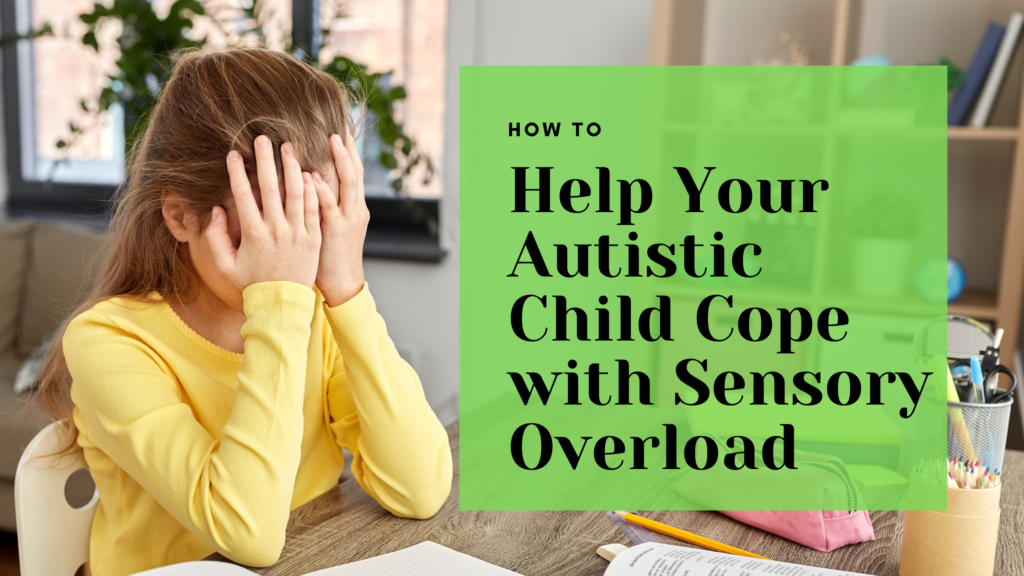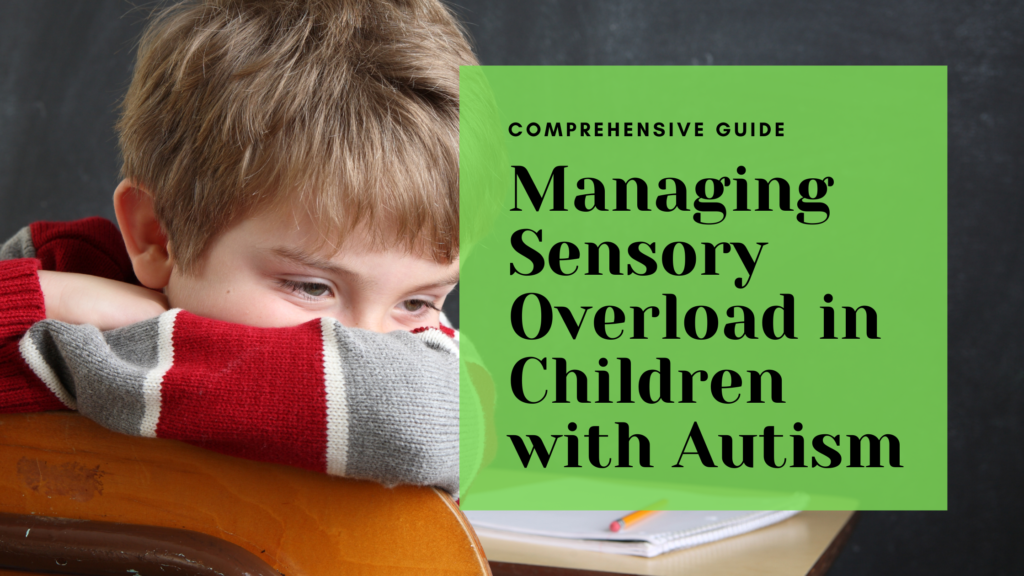I. Introduction
Sensory avoidance is a common experience for many autistic children, where they actively try to avoid certain sensory stimuli because it overwhelms or distresses them. This can affect their daily lives, from how they interact with their environment to their ability to focus in school or participate in activities like eating or playing.
Understanding sensory avoidance is important for parents, caregivers, and educators because it allows them to offer the right support. By recognizing the triggers and creating supportive environments, children can better navigate their sensory world without becoming overwhelmed. This article will explore what sensory avoidance is, the common triggers, and effective strategies for managing it, both at home and in public.
II. Understanding Sensory Avoidance in Autism
Sensory avoidance occurs when an autistic child becomes hypersensitive to specific stimuli, such as loud sounds or bright lights, and tries to avoid them. This is different from sensory seeking, where a child actively seeks out sensory experiences, like spinning or touching different textures, to satisfy their sensory needs.
Children with sensory avoidance might find certain sounds too loud, touches too rough, or lights too bright. These sensitivities can make it hard for them to engage in everyday activities like eating, playing, or attending school. Sensory avoidance is usually a response to sensory overload, where the brain cannot process too much information at once. As a result, the child may shut down or become anxious to avoid further distress.
III. Common Sensory Triggers for Sensory Avoidance
Auditory Sensitivity
One of the most common triggers for sensory avoidance is auditory sensitivity. Loud noises, such as sirens, alarms, or even everyday sounds like vacuum cleaners, can feel overwhelming. Crowded environments with constant background noise, like classrooms or malls, may also cause distress.
Visual Sensitivity
Bright lights, fast-moving visuals, or cluttered environments can be visually overstimulating for some autistic children. Fluorescent lights or fast-moving crowds can make the child feel overwhelmed, leading to avoidance behaviors like closing their eyes or withdrawing from the situation.
Tactile Sensitivity
Tactile sensitivity refers to discomfort with touch. For example, some children may find certain fabrics like wool too itchy, or they might be bothered by tags on clothing. Unexpected physical contact, such as a hug, can also trigger tactile avoidance.
Olfactory and Gustatory Sensitivity
Strong smells, such as perfumes, cleaning products, or certain foods, can overwhelm a child’s olfactory system. Similarly, gustatory sensitivity, which involves the taste and texture of food, can cause avoidance during meals. Children may reject foods based on their texture or smell, making mealtime challenging.
Vestibular and Proprioceptive Sensitivity
Some autistic children experience vestibular (balance) or proprioceptive (body awareness) sensitivities. These can make activities involving movement, such as swinging, climbing, or even walking, uncomfortable. As a result, children may avoid physical activities that challenge their sense of balance or spatial awareness.
IV. Recognizing the Signs of Sensory Avoidance in Autistic Children
Behavioral Signs
Children who experience sensory avoidance often show behavioral signs such as covering their ears in response to loud noises, closing their eyes when faced with bright lights, or refusing to touch certain objects. They might also avoid certain activities or locations that they associate with overwhelming stimuli.
Emotional Responses
Sensory avoidance can trigger strong emotional reactions such as frustration, anxiety, or meltdowns. When faced with a sensory trigger, the child may become visibly upset, cry, or have difficulty calming down.
Social Withdrawal
In some cases, sensory avoidance leads to social withdrawal, where the child avoids group activities or prefers to be alone to escape overwhelming stimuli. This can make it harder for them to participate in social interactions, leading to isolation.
V. Strategies for Supporting a Child with Sensory Avoidance
Modify the Environment
One of the most effective ways to support a child with sensory avoidance is to modify their environment. For example, reducing noise in the home by using carpets or soft furnishings to absorb sound, or adjusting lighting to avoid harsh overhead lights, can help minimize sensory overload.
Introduce Gradual Exposure
Gradual exposure to sensory stimuli can help children build tolerance over time. This technique involves introducing challenging stimuli slowly and in a controlled way, allowing the child to adjust without feeling overwhelmed.
Create Sensory-Friendly Spaces
Setting up sensory-friendly spaces at home or school can give the child a safe place to retreat when they feel overwhelmed. These spaces can include calming objects like soft lighting, weighted blankets, or noise-cancelling headphones.
Respect Personal Boundaries
It’s important to respect the child’s sensory boundaries. Allow them to have control over their environment whenever possible, and avoid forcing them into situations that cause discomfort. This empowers them and reduces the likelihood of meltdowns.
VI. Sensory Tools to Help Manage Sensory Avoidance
Noise-Cancelling Headphones
Noise-cancelling headphones are an effective tool for blocking out overwhelming sounds. They can be used in loud environments, such as restaurants or shopping malls, to help the child feel more comfortable.
Weighted Items
Weighted blankets, vests, or lap pads can provide deep pressure, which has a calming effect on the nervous system. These items are especially helpful when a child is feeling overwhelmed and needs to relax.
Fidget Tools
Sensory fidget toys like stress balls or spinners can help the child self-regulate by giving them something to focus on when they feel anxious or overstimulated.
Calming Visuals and Lighting
Soft lighting or calming visuals like sensory bottles or visual timers can reduce visual overstimulation. These tools create a soothing environment and can help the child focus when feeling overwhelmed.
VII. Collaborating with Therapists and Educators to Support Sensory Avoidance
Work with Occupational Therapists
Occupational therapists (OTs) are key professionals in helping children manage sensory sensitivities. OTs can assess the child’s sensory needs and create a sensory diet, which is a personalized plan of activities designed to help the child manage sensory input throughout the day.
Educator Involvement
Teachers play an important role in supporting sensory avoidance in the classroom. Educators can create sensory-friendly classroom environments, offer accommodations like sensory breaks, and use flexible seating arrangements to help students manage their sensory sensitivities.
Consistent Communication with Parents
It’s important for parents, therapists, and teachers to maintain consistent communication. This collaboration ensures that everyone is aware of the child’s sensory needs and can work together to support them effectively.
VIII. Coping Strategies for Public Spaces
Plan Ahead for Outings
When taking the child into sensory-rich environments, planning ahead is essential. Visiting public spaces during quieter times and bringing sensory tools like noise-cancelling headphones can help reduce anxiety.
Identify Safe Zones in Public Spaces
Look for quiet areas in malls, parks, or restaurants where the child can take sensory breaks if they become overwhelmed. Knowing where these safe zones are can help both the child and caregiver feel more prepared.
Portable Sensory Kits
A portable sensory kit can be a lifesaver when out in public. Include items like noise-cancelling headphones, fidget toys, and calming scents to help manage sensory triggers on the go.
IX. Long-Term Strategies for Managing Sensory Avoidance
Gradually Build Tolerance
Over time, it’s important to gradually build the child’s tolerance to sensory stimuli through controlled exposure. This process helps the child become more comfortable with challenging environments without feeling overwhelmed.
Monitor and Adjust Sensory Interventions
Regularly monitor how the child responds to different sensory stimuli and adjust the strategies as their needs evolve. This helps ensure that interventions remain effective and supportive.
Celebrate Small Wins
Celebrating small victories is essential for reinforcing positive progress. Whether it’s tolerating a new texture or staying calm in a noisy environment, these achievements should be recognized and celebrated.
X. Conclusion
Supporting a child with sensory avoidance is key to helping them feel more comfortable and confident in their daily activities. By creating sensory-friendly environments, using appropriate tools, and working closely with therapists and educators, parents and caregivers can make a big difference in the child’s well-being. It’s important to remain flexible and responsive to the child’s evolving sensory needs, ensuring they receive the individualized support they deserve.
References:
- American Psychiatric Association. (2013). Diagnostic and Statistical Manual of Mental Disorders (5th ed.) (DSM-5).
- Baranek, G. T. (2002). Efficacy of sensory and motor interventions for children with autism. Journal of Autism and Developmental Disorders, 32(5), 397-422.
- Schaaf, R. C., & Davies, P. L. (2010). Evolution of the sensory integration frame of reference. American Journal of Occupational Therapy, 64(3), 363-367.
- National Autistic Society. (2020). Sensory differences. Retrieved from https://www.autism.org.uk/
Here’s a table with 10 key points based on the article:
| # | Key Point | Description |
|---|---|---|
| 1 | Understand Sensory Avoidance | Recognize that sensory avoidance occurs due to hypersensitivity to certain stimuli, causing discomfort and stress. |
| 2 | Identify Common Sensory Triggers | Be aware of triggers like loud noises, bright lights, certain textures, or strong smells that may cause sensory avoidance. |
| 3 | Observe Behavioral and Emotional Signs | Watch for signs such as covering ears, avoiding eye contact, refusing touch, or becoming anxious in sensory-rich environments. |
| 4 | Create Sensory-Friendly Spaces | Set up quiet, sensory-friendly zones at home or school with calming tools like soft lighting, noise-cancelling headphones, and weighted blankets. |
| 5 | Use Gradual Exposure Techniques | Gradually introduce sensory stimuli in controlled, calm environments to help the child build tolerance over time. |
| 6 | Respect Personal Sensory Boundaries | Allow the child control over their environment by respecting their boundaries and adjusting stimuli based on their comfort. |
| 7 | Utilize Sensory Tools | Provide sensory tools like fidget toys, noise-cancelling headphones, or weighted items to help manage and reduce sensory overload. |
| 8 | Work with Therapists and Educators | Collaborate with occupational therapists and teachers to create individualized sensory plans and make classroom accommodations. |
| 9 | Plan for Public Spaces | Prepare for outings by bringing a sensory toolkit and identifying quiet areas where the child can retreat if overwhelmed. |
| 10 | Monitor Progress and Adapt Strategies | Regularly assess how the child is responding to sensory stimuli and adjust support strategies as their sensory needs change. |
This table outlines key points to keep in mind when supporting an autistic child with sensory avoidance, offering practical strategies for managing sensory triggers and creating supportive environments.


